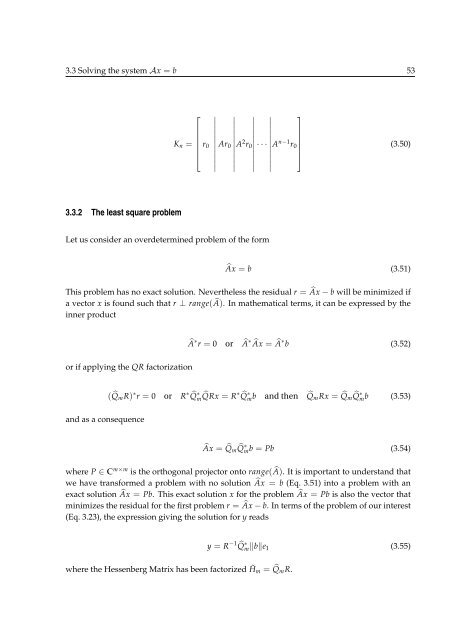THESE de DOCTORAT - cerfacs
THESE de DOCTORAT - cerfacs
THESE de DOCTORAT - cerfacs
Create successful ePaper yourself
Turn your PDF publications into a flip-book with our unique Google optimized e-Paper software.
3.3 Solving the system Ax = b 53<br />
⎡ ∣ ∣ ∣ ⎤<br />
∣∣∣∣∣∣∣∣∣∣ ∣∣∣∣∣∣∣∣∣∣ ∣∣∣∣∣∣∣∣∣∣ K n =<br />
r<br />
⎢ 0 Ar 0 A 2 r 0 · · ·<br />
A n−1 r 0 ⎥<br />
⎣<br />
⎦<br />
∣<br />
(3.50)<br />
3.3.2 The least square problem<br />
Let us consi<strong>de</strong>r an over<strong>de</strong>termined problem of the form<br />
Âx = b (3.51)<br />
This problem has no exact solution. Nevertheless the residual r = Âx − b will be minimized if<br />
a vector x is found such that r ⊥ range(Â). In mathematical terms, it can be expressed by the<br />
inner product<br />
 ∗ r = 0 or  ∗ Âx =  ∗ b (3.52)<br />
or if applying the QR factorization<br />
( ̂Q m R) ∗ r = 0 or R ∗ ̂Q ∗ m ̂QRx = R ∗ ̂Q ∗ mb and then ̂Q m Rx = ̂Q m ̂Q ∗ mb (3.53)<br />
and as a consequence<br />
Âx = ̂Q m ̂Q ∗ mb = Pb (3.54)<br />
where P ∈ C m×m is the orthogonal projector onto range(Â). It is important to un<strong>de</strong>rstand that<br />
we have transformed a problem with no solution Âx = b (Eq. 3.51) into a problem with an<br />
exact solution Âx = Pb. This exact solution x for the problem Âx = Pb is also the vector that<br />
minimizes the residual for the first problem r = Âx − b. In terms of the problem of our interest<br />
(Eq. 3.23), the expression giving the solution for y reads<br />
y = R −1 ̂Q ∗ m‖b‖e 1 (3.55)<br />
where the Hessenberg Matrix has been factorized ˜H m = ̂Q m R.
















